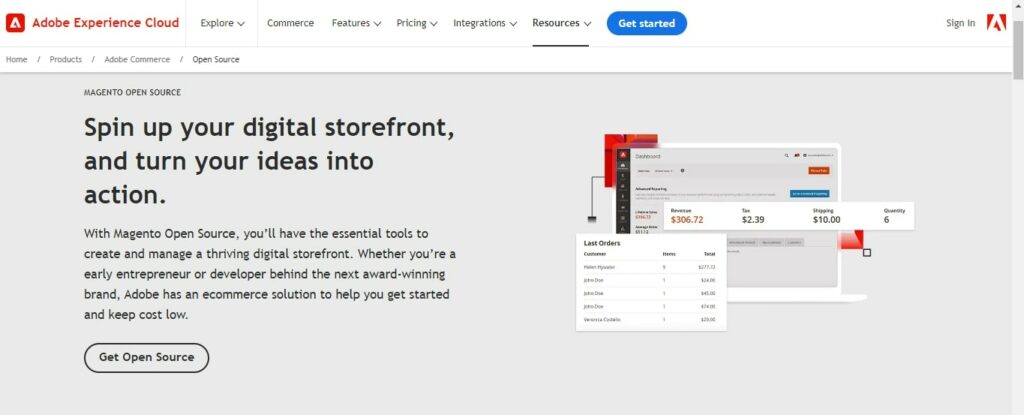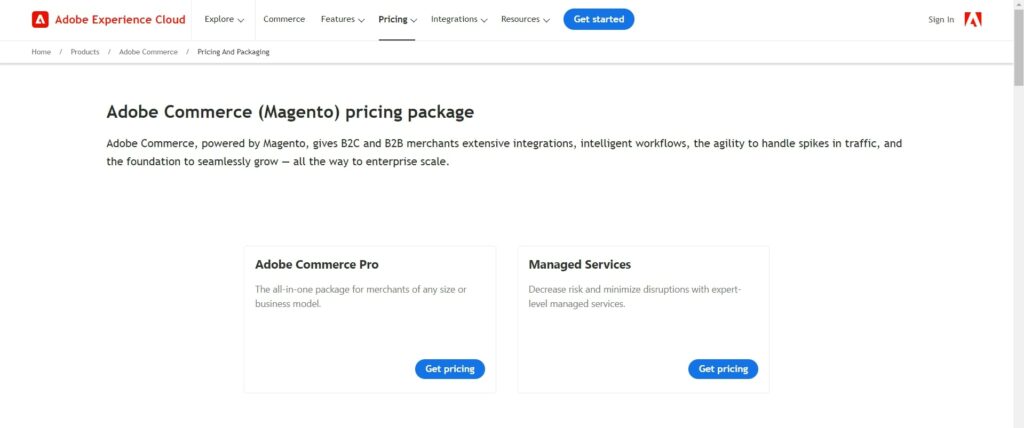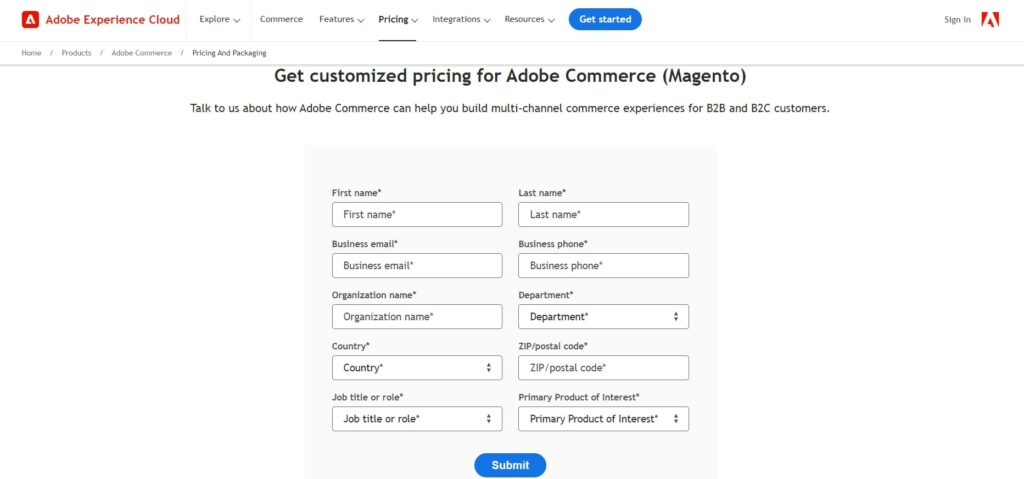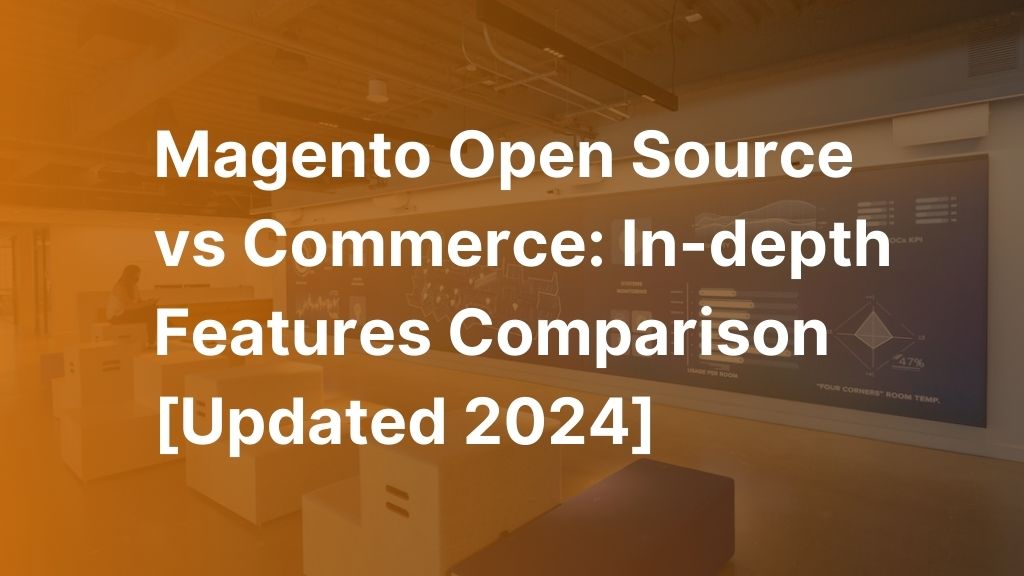Magento is widely recognized as a top-notch platform for constructing quality eCommerce websites. Many businesses rely on this platform to establish their online stores. Magento offers two editions, namely the Open Source and Commerce editions, catering to distinct business sectors with varying sets of features and services. Consequently, the question of “Magento Open Source vs Commerce, which one is better?” poses a perplexing dilemma for many users.
If you are contemplating between Adobe Commerce and Magento Open Source for your entry into the eCommerce industry, this article aims to provide you with a detailed analysis, including the advantages offered by each platform, and conduct a thorough comparison to assist you in determining which one holds greater benefits. Don’t hesitate any longer; let’s scroll down to view details.
Magento Open Source vs Commerce: At a Glance
Table of Contents
Introduction to Magento Open Source
Magento Open Source, developed by Adobe, is a PHP-based eCommerce software that provides essential tools for creating and managing a successful digital storefront. Whether you are a new entrepreneur or a developer aiming to build a renowned brand, Adobe offers an eCommerce solution that is both user-friendly and cost-effective.

With over 200,000 online retailers utilizing Magento, it has become a popular choice in the eCommerce industry. Its popularity can be attributed to its user-friendly interface and extensive range of features.
One notable aspect of Magento is its modular structure, which allows for easy customization and extension. However, it is important to note that Magento is specifically designed for web stores, rather than general website content management.
Who Is an Ideal Fit for Magento Open Source?
Magento Open Source is an optimal choice for businesses of all kinds with its affordable initial investment. This advantageous feature ensures that small-budget businesses can avoid any financial burdens associated with platform maintenance. Moreover, open source offers all the essential functionalities required for the smooth operation of online stores and small businesses.
Pros and Cons
Pros
- Free to download and install
- High degree of flexibility
- SEO capabilities for building an eCommerce business
- Supports omnichannel retailing and is optimized for mobile
- Large and active community that can provide help and support
Cons
- Magento can be complex to use, especially for beginners
Introduction to Adobe Commerce
Adobe Commerce, previously recognized as Magento Commerce, is a highly adaptable and expandable commerce platform that empowers you to craft distinctively customized B2B and B2C experiences, no matter how many brands you have.

Adobe Commerce is a comprehensive cloud-based rendition of Magento, seamlessly incorporating Adobe’s suite of tools, including Analytics Cloud, Marketing Cloud, and Advertising Cloud. Moreover, it encompasses a plethora of novel functionalities, such as a user-friendly dashboard for the management of the company’s eCommerce strategy and seamless integration with the Amazon marketplace.
Who Is an Ideal Fit for Adobe Commerce?
Adobe Commerce is specifically designed to cater to the needs of larger businesses that have a stable financial position. This version necessitates direct engagement with the seller. Moreover, the Commerce edition encompasses B2B solutions that are essential for businesses engaged in collaborations with other businesses, an aspect that smaller stores often overlook.
Furthermore, the platform provides a wide range of advanced functionalities that are specifically designed to enhance the workflow of big businesses, surpassing the basic features offered by Magento Open Source.
Pros and Cons
Pros
- Scalability: Adobe Commerce is an open-source solution that can be used for an online shop even as the business grows
- Customization: You’ll be able to fully customize your online shop
- Omnichannel Support: It includes tools to link your online shop, physical shop, and other sales channels
- Robust and feature-rich: Adobe Commerce is known for its robustness and rich set of features
- Strong SEO: Adobe Commerce has strong SEO capabilities
Cons
- Requires Server: To use Adobe Commerce, you need to provide the server
- Requires Expertise: You’ll consistently need help from experts to create and modify your online shop
- Costly: While Adobe Commerce itself may not be expensive, the costs associated with development, customization, and maintenance can add up
Check out our What is Magento eCommerce article to have detailed information about different versions of Magento.
The Difference Between Magento Open Source and Commerce
In this section below, BSS Commerce will analyze the two options, Adobe Commerce vs Magento Open Source, according to the following criteria: Cost, Hosting, Performance, B2B and B2C Functionality, Scalability, Security, and Support:
Magento Open Source vs Commerce: Cost
Magento Open Source
While Magento Open Source is a free and open-source platform, there are still costs associated with hosting, development, and third-party extensions that need to be considered. These costs will contribute to your overall Magento website cost of ownership.
In addition to these costs, you will also need to pay separately for general website upkeep, backups, your domain name, web hosting, and any customizations you require. It is worth noting that the open-source product does not include Payment Card Industry compliance, so you will need to pay for that separately as well. The total cost will depend on the specific services you choose.
Adobe Commerce
Adobe Commerce provides customers with two pricing options:
- Adobe Commerce Pro
- Managed Services

However, regrettably, both of these options lack transparent, fixed-cost pricing. Unlike other website builders that offer specific pricing. To obtain pricing information, you will need to click on the “Get Pricing” button, which will redirect you to a form resembling the following:

This is because Adobe Commerce is a personalized solution designed specifically for the precise requirements of your business, including its size, industry, order volume, and various other factors. Therefore, each business of various sizes will have varying pricing.
1. Adobe Commerce Pro
Adobe Commerce Pro is a comprehensive solution for merchants of all sizes and business models. However, despite being more cost-effective than the Managed Services package, it is not recommended for merchants of any size.
Even the most basic and affordable option, Adobe Commerce, is better suited for larger eCommerce businesses. For those who are just starting or have a lower monthly order volume, BSS Commerce recommends considering alternatives such as Shopify or BigCommerce. You can refer to the full comparison here:
Here is what is included in Adobe Commerce Pro:
| Adobe Commerce application | Varnish-based CDN (Content Delivery Network) | Expansive monitoring and alerting |
| Core application support | Image optimization | Scale globally on AWS (Amazon Web Services) and Azure |
| Single-tenet, dedicated infrastructure | DDoS (Distributed Denial of Service) protection and WAF (Web Application Firewall) | Secure and dedicated cloud infrastructure |
| Deployment tools | Performance monitoring tools | Incident service level target |
| Dedicated staging environment | Infrastructure support | Surge capacity monitoring and response |
| Increased customization | Technical Account Manager | Infrastructure security |
| 50GB of testing | High availability architecture | Infrastructure level 99.9% SLA (Service Level Agreement) |
| Disaster recovery and data retention | Automated data backup |
This comprehensive compilation of features and functionality clearly distinguishes Adobe Commerce from other competitors in terms of its offerings. However, this extensive list also positions Adobe Commerce as a website builder suitable for enterprise-level e-commerce, catering primarily to larger and well-established businesses.
2. Managed Services
Adobe Commerce’s Managed Services plan includes all the features of Adobe Commerce Pro, along with some additional features as follows:
| Application level 99.9% SLA | Planned event management support | Go-live process coaching |
| 30-minute SLT (Service Level Target) for P1 | Customized site monitoring and personalized run book | Dedicated escalation management |
| Designated cloud infrastructure resource (Customer Success Engineer) | Upgrade and patching development assistance | Application monitoring assistance |
Managed services are exclusively recommended for eCommerce businesses that are of significant size, possess extensive requirements, and have a larger customer base.
The Final Verdict: In general, Magento Open Source vs Commerce doesn’t have clear and transparent pricing, leading to confusion for anyone intending to use them. It can be claimed that this is not a beneficial element for both platforms. However, identifying the pricing based on the context and scale of each business may be an advantage to businesses because they can pay a reasonable price for what they invest.
Hosting
When selecting a Magento edition, it is essential to consider the server space and resources needed to maintain your website. Here is the hosting information for both platforms Magento Open Source vs Adobe Commerce:
Magento Open Source
Adobe does not offer any hosting services for Magento Open Source. Therefore, you will need to choose and pay for a hosting provider. Additionally, you will be responsible for managing and configuring your hosting settings, including backup, storage, bandwidth, and server type.
Adobe Commerce
There are two hosting options available on Adobe Commerce (Magento):
- Adobe Commerce Cloud: This service operates on AWS and offers excellent availability, scalability, and security. It is included in the license fee and provides additional features such as Blackfire.io, Fastly CDN, New Relic APM, and more.
- On-Premise: With this option, you have the freedom to select and pay for your hosting provider, similar to Magento Open Source. However, setting up and maintaining this option requires technical skills and resources.
The Final Verdict: When comparing Adobe Commerce vs Magento Open Source, Adobe Commerce is a better option for hosting. For deeper insights into Magento hosting, check out the Best Magento 2 Hosting Sites article from BSS Commerce
Performance
The performance of a website is a major concern for business owners, often having a significant impact on their customer’s shopping experience. However, when comparing the performance of Magento Open Source vs Adobe Commerce, it becomes a complex task due to various external factors like server capabilities and internet connection quality:
Magento Open Source
Magento Open Source is free to use. It is a suitable option for small to medium-sized businesses. However, it is important to note that as the business grows or experiences sudden spikes in demand, there might be certain performance limitations. These limitations have the potential to affect the revenue and opportunities of the business.
Adobe Commerce
Adobe Commerce is a premium solution that merges the flexibility of Magento Open Source with additional enterprise-grade capabilities. It’s designed for scalability and performance, adept at supporting large catalogs, high transaction volumes, and global regions.
Impressively, Adobe Commerce can handle 208,000 orders per hour, 2 million pageviews per hour, and 242 million effective SKUs. In a performance benchmark test, it processed 3,481 orders per minute while maintaining response times of less than 2 seconds for the 99th percentile.

Source: https://business.adobe.com/
Adobe Commerce can enhance the performance of your eCommerce platform using intelligent workflows and is capable of handling traffic spikes.
The Final Verdict: To sum up, Magento Open Source is a reliable and adaptable option for small to medium-sized enterprises. Adobe Commerce offers enhanced performance and scalability, making it more suitable for larger businesses or those with significant transaction volumes. Nevertheless, the optimal choice ultimately hinges on your specific business requirements and available resources. It is advisable to conduct a comprehensive analysis before reaching a decision.
B2B and B2C Functionality
In terms of functionality, there is a significant difference between Magento Open Source vs Commerce when it comes to B2C and B2B capabilities. While Magento Open Source is primarily focused on B2C, it lacks the specialized features that Adobe Commerce offers for B2B platforms.
Both versions provide comparable features for B2B and B2C eCommerce, such as product catalogs, shipping options, tax calculations, shopping carts, customer accounts, reviews, and checkout processes. However, Adobe Commerce goes a step further by providing additional capabilities specifically designed for B2B:
- Quick Order: With Adobe Commerce, you can enjoy a more efficient checkout experience, reducing the time it takes to complete B2B orders. Through utilizing a wish list feature and a simple click to add items to the shopping cart, the ordering process becomes quicker and more convenient.
- Requisition List: Sellers have the ability to create requisition lists, making it effortless to reorder items based on buyer intentions. These lists can be customized to suit specific needs, allowing for unlimited ticket lists that can be assigned to selected clients.

- Custom Catalogs And Pricing: Adobe Commerce empowers users to create and assign custom catalogs and pricing rules for different customer segments, such as distributors, retailers, and wholesalers. This enables businesses to offer competitive and personalized prices to B2B buyers, enhancing their shopping experience.
- Quote Management And Negotiation: Users can efficiently manage and negotiate quotes with B2B buyers using Adobe Commerce. , which includes the ability to offer discounts, shipping options, or coupons, all aimed at increasing conversions and driving sales.
- Credit Limit And Payment Terms: In Adobe Commerce, users have the ability to establish credit limits and payment terms for B2B buyers with some options such as net 15, 30, 45, and 60 days, providing a flexible and convenient way to manage payments and enhance cash flow.
Plus, Adobe Commerce offers a range of B2C-specific features, including:
- Customer segmentation and personalization: Users can segment customers based on various factors such as location, gender, behavior, age, or purchase history.
- Loyalty programs: Businesses can implement loyalty programs that reward customers for their purchases or set rules and rewards for different tiers and levels of loyalty.
- Content staging and preview: Adobe Commerce provides features that enable users to stage and preview content changes before launching them, including approving banners, products, or promotions and scheduling content changes to go live at specific times.
The Final Verdict: For businesses with less specific or complex B2C or B2B requirements, the Magento open-source version is often sufficient. However, there is also the option to switch to the feature-packed Adobe Commerce for more advanced functionality.
Scalability
The scalability of your Magento Commerce option is crucial in handling transactions, data, and traffic without compromising performance, functionality, or security:
Magento Open Source
For businesses that do not have high traffic volumes, the open-source version of Magento presents a reasonable choice. However, larger enterprises that foresee growth and expansion should consider the more flexible Adobe Commerce to meet their scalability needs.
Adobe Commerce
The Adobe Commerce platform offers features specifically designed to enhance scalability. These include a drag-and-drop page builder for codeless content creation and editing with preview features, customer segmentation and personalization, loyalty programs, and a B2B module.
The Final Verdict: It can be claimed that Adobe Commerce is a more ideal option compared to Magento Open Source in terms of scalability.
Security
Security is of the utmost importance for any online business. It serves as a crucial factor in gaining the trust of customers and preventing any financial losses.
Magento Open Source
Magento Open Source’s Payment Services offers a comprehensive self-service solution that encompasses sandbox testing and a user-friendly setup, ensuring reliable and secure payment processing.
However, when using Magento Open Source, the responsibility of ensuring security lies with you. This means that you will have to actively stay updated with the latest security patches and updates released by Adobe and apply them manually. Also, you must comply with the Payment Card Industry Data Security Standard (PCI DSS) to ensure secure payment transactions. To further enhance security, it is essential to use the HTTPS protocol, which requires the installation of an SSL certificate.
In general, to effectively operate the open-source version, your business must possess the necessary technical expertise to identify and deploy the required security features consistently throughout its lifespan.
Adobe Commerce
In contrast to Magento Open Source, Adobe Commerce provides regular security patches and updates that are automatically applied to your website to make sure that your site remains secure and protected against potential vulnerabilities.
Also, Adobe Commerce offers PCI-DSS compliance for payment security. This means that your customers’ credit card information is handled in a secure manner, reducing the risk of data breaches.
Another important feature of Adobe Commerce is credit card tokenization, which replaces sensitive information with a unique identifier, minimizing the exposure of sensitive data. About payment security, Adobe Commerce offers popular services like PayPal, Amazon Pay, Braintree, and more to secure and seamless payment transactions on your website.
The Final Verdict: In a nutshell, Adobe Commerce is still a better option in terms of security.
Support
Magento Open Source
Magento Open Source is a community-driven platform. It does not have official support from Adobe, so users are dependent on the community, forums, and third-party vendors for support and extensions. Despite this, there’s a large and active open-source community that provides substantial support, making Magento Open Source a viable choice for many businesses.
In addition, there are Magento agencies that can help you build your store from scratch or extend its functionalities with their advanced customization techniques. Among these, BSS Commerce emerges as one of the leading Magento development companies, boasting over 11 years of unwavering commitment in the eCommerce landscape.
With robust expertise and exceptional dedication from certified Magento experts, our Magento development services will help you craft an unparalleled eCommerce store, efficiently boosting your online sales growth.
Adobe Commerce

Adobe Commerce, a premium solution, provides its users with a range of official Magento support and maintenance services. These include service level agreements (SLAs), security updates, and patches. In addition, users can reach out to Magento’s support team for assistance. However, it’s important to note that to access this official support, a paid plan from Adobe is required to make sure that users receive the best possible service and support for their Adobe Commerce platform.
In addition, Adobe provides a range of support tools aimed at enhancing your eCommerce store experience. This platform offers personalized best practices, diagnostic and monitoring tools, as well as up-to-date information about your site. These resources are designed to assist and allow you to improve your overall online store performance.
The Final Verdict: Both Magento Commerce vs Open Source offer documentation that is specifically tailored to merchants. However, if your business believes that having direct support from Adobe would be advantageous and you are willing to bear the additional expenses, choosing Adobe Commerce is the better choice.
Third-Party Extensions
Magento Commerce and Adobe Commerce both offer a robust ecosystem of third-party extensions to enhance their core functionality. However, there are some key differences in terms of availability, compatibility, and support.
Availability and Variety
- Magento Open Source: Offers a vast marketplace of extensions, catering to a wide range of business needs. You can find extensions for everything from payment gateways and shipping methods to marketing tools and customer support.
- Adobe Commerce: While Adobe Commerce also has a marketplace of extensions, it might be slightly more limited in terms of variety compared to Magento Open Source. This is because Adobe Commerce is a more tightly integrated platform, and extensions need to adhere to stricter compatibility standards.
Compatibility and Integration
- Magento Open Source: Due to its open-source nature, Magento Open Source offers more flexibility in terms of compatibility. Developers have more freedom to create and customize extensions, potentially leading to a wider range of options. However, this can also introduce compatibility issues if extensions are not well-maintained or tested.
- Adobe Commerce: Adobe Commerce has a more controlled ecosystem, ensuring that extensions are thoroughly tested and compatible with the platform. This can provide greater stability and reliability, but it might limit the customization options available.
Support and Maintenance
- Magento Open Source: Support for third-party extensions can vary widely. Some extensions come with dedicated support from their developers, while others might have limited or no support. It’s essential to research the reputation and support policies of the extension provider before purchasing.
- Adobe Commerce: Adobe Commerce often provides more assurance regarding the quality and support of third-party extensions. The platform’s marketplace might have stricter guidelines for developers, ensuring that extensions meet certain standards.
Both Magento Open Source and Adobe Commerce offer a rich ecosystem of third-party extensions. However, the availability, compatibility, and support for these extensions can vary between the two platforms. Online businesses should carefully consider their specific needs and preferences when choosing between Magento Commerce and Adobe Commerce, taking into account the factors mentioned above.
Alternatively, you may consider using the BSS Magento 2 Extensions, which offers a vast selection of both free and paid extensions.
Upgrade Your Magento Experience Today – Enjoy One Price for All Magento Editions! Shop Now with BSS Commerce Magento 2 Extensions and Simplify Your eCommerce Growth!
Magento Open Source vs Commerce: Wrapping Up
Users have the advantage of leveraging the versatile capabilities of both open source and commerce as they utilize the same technology stack. When comparing Magento Open Source vs Commerce, it is crucial to carefully evaluate the advantages and disadvantages of each platform to determine the most suitable option for your business.
If you prefer a safe start, BSS Commerce strongly suggests considering Magento Open Source, as it caters to businesses of all sizes and affordable budgets. However, to further enhance the capabilities of open source for larger businesses, you can consider using Adobe Commerce.
Adobe On Premise vs Adobe Commerce Cloud: A Brief Overview
That’s Magento Open Source and Commerce. Let’s go further to understand Adobe Commerce On-Premise vs. Adobe Commerce Cloud.
Introduction to Adobe On Premise
Adobe On Premise, now known as Adobe Commerce, is the self-hosted version of Adobe’s eCommerce platform (a solution that businesses install and manage on their own hardware). Adobe On Premise stands out with extensive customization capabilities. Such features enable merchants to make changes to every aspect of their eCommerce setup, fitting them to particular business requirements and the existing systems.
Introduction to Adobe Commerce Cloud
Adobe Commerce Cloud, previously called Magento Commerce Cloud, is a fully managed, cloud-based version of the Adobe Commerce platform. Simply put, it is the combination of the on-premise solutions and a cloud-native. Employing built-in AWS hosting, this all-in-one package provides everything you need, from hosting infrastructure to servers, email services, and SSL certificates, all within a secure and reliable cloud environment.
It is perfect for medium to large companies that would like a little of both customization and ease of management.

The Difference Between Adobe On Premise vs Adobe Commerce Cloud
While being powerful eCommerce solutions, the Adobe On Premise vs Adobe Commerce Cloud editions differ significantly in costs, hosting, performance, functionality, scalability, security, and support.
Cost
Both Adobe Commerce, or Magento Commerce, and Adobe Commerce Cloud are tiered and based on Gross Merchandise Value (GMV) and Average Order Volume (AOV). In other words, the software licensing fees vary depending on your store’s sales volume and average order size.
Generally, the cost for Adobe On Premise ranges from $22,000 to $125,000 per year. However, this is just a base cost, and it hasn’t included additional expenses for hosting, IT personnel, security, and maintenance yet.
The Commerce Cloud version typically starts at a higher price point due to the included cloud infrastructure and advanced features. The annual price can range from $40,000 to $190,000, without considerations for extra costs for data transfer, storage, and potentially additional services.
| Adobe On Premise base package | Magento Commerce Cloud |
|
|
Verdict: As these costs are pretty not transparent and may vary substantially upon the case of the business needs and scale, it is very important to weigh up both options with caution and get full-fledged quotations from Adobe.
Hosting
The key difference between Adobe Commerce On-Premise and Adobe Commerce Cloud lies with respect to the method of hosting. While Adobe Commerce On-premises will enable you to do hosting from a third party, it also provides the features of Adobe Commerce.
On the other hand, Adobe Commerce Cloud is cloud-hosted and managed. Everything pertaining to infrastructure, server maintenance, security, or upgrades is covered by Adobe so that you can focus on your business.

Verdict: Adobe Commerce Cloud is generally considered better than Adobe Commerce On-Premise. It offers a more streamlined and hassle-free hosting experience compared to On-Premise.
Performance
Adobe Commerce On-Premise offers merchants more control over their store. One can adjust the setup of your servers and systems to meet your specific needs. However, keeping an on-premise store running at its best takes technical skills.
On the other hand, Adobe Commerce Cloud offers a managed system that’s set up to meet your business needs without the need to manage the technical parts. It takes care of the backend stuff, like server resources, load balancing, and caching—creating a fast-working environment for your online store.
Verdict: Adobe Commerce Cloud is generally better for businesses that prefer a managed solution that can scale easily and handle technical backend management.

B2B and B2C Functionality
Adobe Commerce boasts many built-in advanced features to help your store grow. Some include business intelligence dashboards, advanced marketing tools, customer loyalty tools, and visual merchandising. Not to mention, most of the extensions on Commerce Marketplace come free with the Adobe Commerce On-Premise edition.
Adobe Commerce Cloud is basically Adobe Commerce but more feature-rich. Some of its exclusive features include performance monitoring tools, Cloud onboarding Magento support, and a Cloud availability service level agreement (SLA).
Verdict: The Cloud one stands out as the better choice due to its additional tools for enhancing shopping experiences and robust security features.

Scalability
Adobe Commerce is built to grow with your business. It easily handles the needs of medium to large companies with big, complex product catalogs, high sales volumes, multiple online stores, and busy traffic times.
Adobe Commerce Cloud offers a flexible solution that includes all the good things about Adobe Commerce On-Premise, but as a cloud platform. Its system watches your online store and can adjust to keep performance steady and predictable. Commerce Cloud is also more reliable when it comes to loading times or sudden increases in traffic.
Verdict: In terms of scalability, Adobe Commerce Cloud is the better option. It offers automatic resource scaling, which ensures steady performance during high traffic periods without the need for manual intervention.
Security
Adobe Commerce offers basic features to help protect against common security threats. These include a read-only file system, two-factor authentication, password managers, and malware scans. However, it leaves much of the responsibility to merchants.
When it comes to Adobe Commerce Cloud, merchants are only responsible for application security, like platform patches and extension upgrades. Adobe Commerce Cloud follows regulations and provides enhanced security with SSL/TLS certificates, image optimization, and a Content Delivery Network (CDN).
Verdict: Adobe Commerce Cloud is superior in terms of security. It provides comprehensive managed security features, reducing the burden on merchants to manage infrastructure security, which is handled by Adobe, ensuring a more robust and secure environment.

Support
Adobe Commerce On-Premise offers proactive support solutions. This includes a dedicated account manager and 24/7 technical help to solve any store-related problems. You can also use Adobe Commerce Rapid Deployment Packages, which make it easy to set up and launch new features.
Meanwhile, Adobe Commerce Cloud, with a team of professionals, can guide you through the operation and improvement of your online store. Ongoing technical support to make your site function at the highest level with current security updates.
Verdict: Adobe Commerce Cloud is the best in this aspect as it provides a complete support system with expert developers and ongoing technical support.
Adobe On Premise vs Adobe Commerce Cloud: Wrapping Up
It is crucial to decide on the right e-commerce platform since security must be guaranteed, as well as good scalability, flexibility, and reliability. Some of the good choices for those needs would be the Adobe Commerce Cloud, using contemporary cloud computing with an expansible design. Besides, it provides enterprise-level scalability and availability to create great shopping experiences across various brands, websites, currencies, and countries.
Contrasting that, Adobe On Premise Commerce will be suitable for businesses that want to have full control over the hosting environment. It will be perfect for companies that have technical ability in managing and maintaining their systems.
Hope that this article has helped you choose the right platform after comparing Magento Open Source vs Adobe Commerce and Adobe On Premise vs Adobe Commerce Cloud. Don’t forget to visit our blog to explore the most knowledge and information about Magento.


